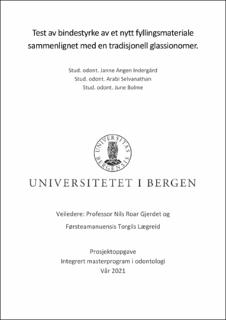| dc.contributor.author | Indergård, Janne Angen | |
| dc.contributor.author | Selvanathan, Arabi | |
| dc.contributor.author | Bolme, June | |
| dc.date.accessioned | 2021-04-15T07:14:29Z | |
| dc.date.issued | 2021-03-01 | |
| dc.date.submitted | 2021-04-14T22:00:43Z | |
| dc.identifier.uri | https://hdl.handle.net/11250/2737841 | |
| dc.description.abstract | Mål: Formålet med denne in vitro-studien var å vurdere bindestyrken mellom tannfyllingsmaterialet ACTIVA™ BioACTIVE RESTORATIVE™ og dentin med og uten bruk av adhesiv. En tradisjonell glassionomersement ble brukt som referanse. Materiale og Metode: To ulike restorative materialer ble testet, fyllingsmaterialet Activa™ BioActive Restorative™ og en glassionomersement. Nylig ekstraherte, kariesfrie visdomstenner ble tilfeldig delt inn i tre grupper: 1: Activa uten bruk av adhesiv (n=7), 2: Activa med bruk av adhesiv (n=6), 3: GIS som referanse (n=6). Testmetoden skjærbindestyrke (SBS) ble anvendt, og resultatene ble registrert i MPa (1MPa = 1000kN/m2) Resultat: Activa med adhesiv viste den høyeste bindestyrken til dentin med en gjennomsnittsmåling på 12,13MPa, mens Activa uten adhesiv hadde den statistisk signifikant svakeste bindestyrken med en gjennomsnittsmåling på 0,25MPa. Kontrollgruppen med glassionomersement hadde en gjennomsnittsmåling på 3,60MPa. Det var signifikante forskjeller mellom alle gruppene (p<0,05). Konklusjon: Gjennom denne studien ble det funnet at produktet Activa™ BioActive Restorative™ lagt uten adhesiv i henhold til bruksanvisning fra 2018 resulterte i en svært svak bindestyrke som ikke forsvalig kan brukes i klinisk praksis. Ved forbehandling gjennom bruk av adhesiv gav materialet en tilfredsstillende bindestyrke som overgikk kontrollgruppen med glassionomersement. | |
| dc.description.abstract | Objective: The aim of this in-vitro study was to evaluate the bond strength to dentine of a newer restorative material (Activa BioACTIVE Restorative, Pulpdent, Watertown, MA, USA) using both the original and the revised directions for use (DFU). A glass ionomer (GC Fuji IX GP Fast, GC Corporation, Tokyo, Japan) was used as control. The null hypothesis was that the pre-treatment, or choice of restorative material would not affect the bond strength. Materials and method: Two different restorative materials were tested, the restorative material Activa TM BioActive Restorative TM and a glass ionomer cement. Nineteen extracted sound human third molars were randomly divided into three groups: 1: Activa BioACTIVE Restorative without the use of an adhesive (original DFU; n=7), 2: Activa BioACTIVE Restorative with the use of a 3-step adhesive (OptiBond FL, Kerr Italia Srl, Scafati, Italy) (revised DFU; n=6), 3: Glass ionomer (GC Fuji IX GP Fast) (control; n=6). Cylinders with a diameter of 2.8mm were made on the dentine surfaces. The shear bond strength to dentine (in MPa) was measured by a jig mounted in a servohydraulic testing machine. Data was analyzed using non-parametric tests. Results: The bond strength to dentine was significantly different between the groups (p<0.05). Activa BioACTIVE Restorative with an adhesive showed the highest bond strength to dentine with a mean value of 12.13MPa (7.00MPa-20.80MPa), while the group without an adhesive had the statistically significant weakest bond strength with a mean value of 0.25MPa (0.00MPa-1.09MPa). The glass ionomer control group had a mean value of 3.60MPa (1.77MPa-5.61MPa). Conclusion: The bonding to dentine of the new restorative material with claimed bioactive properties was nearly nonexistent when applied without an adhesive as of the original DFU (Dec 2018). Clinical studies indicated inferior performance. When used with a bonding agent, as stated in the revised DFU, the bond strength exceeded that of a conventional glass ionomer. The present study highlights the importance of adequate DFUs. | |
| dc.language.iso | nob | |
| dc.publisher | The University of Bergen | |
| dc.rights | Copyright the Author. All rights reserved | |
| dc.subject | bindestyrke | |
| dc.subject | glassionomersement | |
| dc.subject | dental adhesiv | |
| dc.subject | skjærbindestyrke | |
| dc.subject | Activa | |
| dc.title | Test av bindestyrke av et nytt fyllingsmateriale sammenlignet med en tradisjonell glassionomer. | |
| dc.type | Master thesis | |
| dc.date.updated | 2021-04-14T22:00:43Z | |
| dc.rights.holder | Copyright the Author. All rights reserved | |
| dc.description.degree | Prosjektoppgave / Integrert masteroppgave | |
| dc.description.localcode | OD3PROSJ | |
| dc.description.localcode | MAOD-ODONT | |
| dc.subject.nus | 764106 | |
| fs.subjectcode | OD3PROSJ | |
| fs.unitcode | 13-19-0 | |
| dc.date.embargoenddate | 2023-02-28 | |
